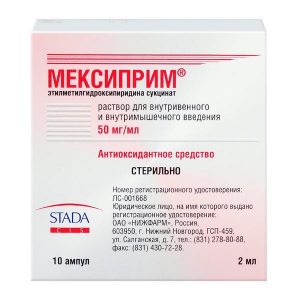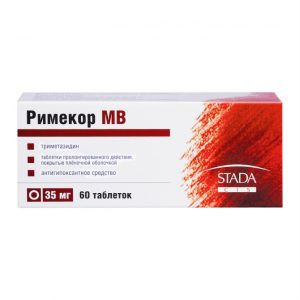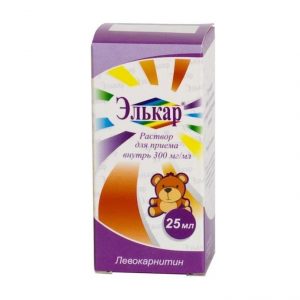Description
Latin name
Fluoxetine
Release form
Capsules 20 mg
Packing
30 pcs
Pharmacological action
Antidepressant group of selective serotonin reuptake inhibitors. It has a timoanaleptic and stimulating effect.
Selectively blocks reverse neuronal uptake of serotonin (5HT) in the synapses of central nervous system neurons. Inhibition of serotonin reuptake leads to an increase in the concentration of this neurotransmitter in the synaptic cleft, strengthens and prolongs its effect on postsynaptic receptor sites. By increasing serotonergic transmission, fluoxetine inhibits the metabolism of the neurotransmitter by the mechanism of negative membrane communication. With prolonged use, fluoxetine inhibits the activity of 5-HT1 receptors. Weakly affects the reuptake of norepinephrine and dopamine. It has no direct effect on serotonin, m-cholinergic, H1-histamine and alpha-adrenergic receptors. Unlike most antidepressants, it does not cause a decrease in the activity of postsynaptic beta-adrenergic receptors.
Effective in endogenous depression and obsessive-compulsive disorders. It has anorexigenic effect, can cause weight loss. It does not cause orthostatic hypotension, sedative effect, non-cardiotoxic. A persistent clinical effect occurs after 1-2 weeks of treatment.
Pharmacokinetics
When administered, the drug is well absorbed from the gastrointestinal tract (up to 95% of the dose taken), use with food slightly inhibits the absorption of fluoxetine. Cmax in plasma is reached after 6-8 hours. The bioavailability of fluoxetine after oral administration is more than 60%. The drug accumulates well in tissues, easily penetrates the blood-brain barrier, binding to plasma proteins is more than 90%. It is metabolized in the liver by demethylation to an active metabolite of norfluoxetine and a number of unidentified metabolites. It is excreted by the kidneys in the form of metabolites (80%) and intestines (15%), mainly in the form of glucuronides. T1 / 2 fluoxetine after reaching equilibrium plasma concentration is about 4-6 days. T1 / 2 of the active metabolite of norfluoxetine with a single dose and after reaching equilibrium plasma concentration is from 4 to 16 days. In patients with liver failure, the half-life of fluoxetine and norfluoxetine is lengthened.
Indications
– depression of various origins
– obsessive-compulsive disorder
– bulimic neurosis.
Contraindications
– simultaneous administration with MAO inhibitors (and within 14 days after their withdrawal)
– simultaneous administration of thioridazine (and within 5 weeks after discontinuation of fluoxetine), pimozide
– pregnancy
– severe dysfunction kidney (creatinine clearance less than 10 ml / min)
– liver failure
– lactase deficiency, lactose intolerance, glucose-galactose malabsorption
– under 18 years old
– hypersensitivity to the drug.
Caution
Suicidal risk: In depression, there is a chance of suicidal attempts that may persist until a stable remission occurs. Individual cases of suicidal thoughts and suicidal behavior are described during therapy or shortly after its completion, similar to the action of other drugs with similar pharmacological effects (antidepressants). Careful monitoring of patients at risk is necessary. Doctors should convince patients to immediately report any thoughts or feelings of concern.
Epileptic seizures: fluxetin should be used with caution in patients with epileptic seizures.
Hyponatremia: there have been cases of hyponatremia. Basically, similar cases were noted in elderly patients and in patients taking diuretics, due to a decrease in the volume of circulating blood.
Diabetes mellitus: glycemic control in patients with diabetes showed hypoglycemia during treatment with fluoxetine, and hyperglycemia developed after drug withdrawal. At the beginning or after treatment with fluoxetine, dosage adjustment of insulin and / or hypoglycemic drugs for oral administration may be required.
Renal / Hepatic Insufficiency: Fluoxetine is metabolized in the liver and excreted by the kidneys and through the gastrointestinal tract. Patients with severe hepatic impairment are recommended to prescribe lower doses of fluoxetine, or to prescribe the drug every other day. When taking fluoxetine at a dose of 20 mg / day for two months, there were no differences in the concentration of fluoxetine and norfluoxetine in the blood plasma of healthy individuals with normal renal function, and patients with severe renal impairment (creatinine clearance of 10 ml / min) requiring hemodialysis.
Use during pregnancy and lactation
Contraindicated in pregnancy and lactation.
Composition of
fluoxetine hydrochloride 22.4 mg,
corresponding to the content of fluoxetine 20 mg
Excipients: lactose monohydrate (milk sugar) – 30.8 mg, microcrystalline cellulose – 16.1 mg, colloidal silicon dioxide – 150 mg aerosol (mg) – aerosol – 600 mcg, talc – 1.15 mg.
Composition of the capsule shell: gelatin – 36.44 mg, titanium dioxide – 1.52 mg, indigo carmine – 40 μg.
Dosage and administration
The drug is taken orally, at any time, regardless of food intake.
Depressed
The initial dose is 20 mg 1 time / day in the morning, regardless of food intake. If necessary, the dose can be increased to 40-60 mg / day, divided into 2-3 doses (20 mg / day weekly). The maximum daily dose is 80 mg in 2-3 doses.
The clinical effect develops 1-2 weeks after the start of treatment, in some patients it can be achieved later.
Obsessive-compulsive disorder
The recommended dose is 20-60 mg / day.
Bulimic neurosis
The drug is used in a daily dose of 60 mg, divided into 2-3 doses.
Use of the drug by patients of different ages
There is no data on dose changes depending on age. Treatment of elderly patients should begin with a dose of 20 mg / day.
Concomitant diseases
Prescribing fluoxetine to patients with impaired hepatic function or is recommended with the use of low doses and prolongation of the interval between doses.
Side effects of
When using fluoxetine, as in the case of using drugs from the group of selective serotonin reuptake inhibitors, the following adverse events are noted.
From the cardiovascular system: often ( 1% – 10%) – atrial flutter, hot flashes infrequently ( 0.1% – 1%) – rarely hypotension ( 0.1%) – vasculitis, vasolidation.
From the digestive system: very often ( 10%) – diarrhea, nausea often ( 1% – 10%) – dry mouth, dyspepsia, vomiting infrequently ( 0.1% – 1%) – dysphagia, taste perversion rarely ( 0.1%) – pain along the esophagus.
From the hepatobiliary system: rarely ( 0.1%) – idiosyncratic hepatitis.
From the side of the immune system: very rarely ( 0.1%) – anaphylactic reactions, serum sickness.
Disorders of metabolism and nutrition: often ( 1% – 10%) – anorexia (including weight loss) of the body.
From the musculoskeletal system: infrequently ( 0.1% – 1%) – muscle twitching.
From the side of the central nervous system: very often ( 10%) – headache often ( 1% – 10%) – impaired attention, dizziness, lethargy, drowsiness (including hypersomnia, sedation), tremor infrequently ( 0.1% – 1%) – psychomotor agitation, hyperactivity, ataxia, impaired coordination, bruxism, dyskinesia, myoclonus rarely ( 0.1%) – buccal gloss syndrome, convulsions, serotonin syndrome.
Mental disorders: very often ( 10%) – insomnia (including early morning awakening, primary and secondary insomnia) often ( 1% – 10%) – unusual dreams (including nightmares), nervousness, tension, decreased libido (including the absence of libido), euphoria, sleep disturbance infrequently ( 0.1% – 1%) – depersonalization, hyperthymia, impaired orgasm (including anorgasmia), impaired thinking ( 0.1%) – manic disorders.
From the skin: often ( 1% – 10%) – hyperhidrosis, itching, polymorphic skin rash, urticaria infrequently ( 0.1% – 1%) – ecchymosis, tendency to bruise, alopecia, rarely cold sweat ( 0.1%) – angioedema, photosensitivity reactions.
From the sensory organs: often ( 1% – 10%) – blurred vision infrequently ( 0.1% – 1%) – mydriasis.
From the genitourinary system: often ( 1% – 10%) – rapid urination (including pollakiuria), impaired ejaculation (including lack of ejaculation, dysfunctional ejaculation, early ejaculation, delayed ejaculation, retrograde ejaculation), erectile dysfunction, gynecological bleeding (including cervical bleeding, dysfunctional uterine bleeding, genital bleeding, menometorrhagia, menorrhagia, metrorrhagia, polymenorrhea, postmenopausal bleeding, uterine bleeding, vaginal bleeding) infrequently ( 0.1% – 1%) – rarely dysuria ( 0.1%) – sexual dysfunction, priapism.
Post-marketing messages
From the endocrine system, there have been cases of insufficiency of antidiuretic hormone.
These side effects often occur at the beginning of fluoxetine therapy or with an increase in the dose of the drug.
Drug Interaction
Fluoxetine and its major metabolite norfluoxetine have long half-lives, which should be considered when combining fluoxetine with other drugs and when it is replaced with another antidepressant.
It is impossible to use the drug at the same time as MAO inhibitors, incl. antidepressants – MAO inhibitors furazolidone, procarbazine, selegiline, as well as tryptophan (a precursor of serotonin), as it is possible to develop serotonergic syndrome, manifested in confusion, hypomaniacal state, psychomotor agitation, convulsions, dysarthria, hypertensive crises, chills, tremors, nausea, diarrhea, nausea.
Fluoxetine should be administered no earlier than 14 days after the administration of MAO inhibitors. MAO inhibitors should not be used earlier than 5 weeks after fluoxetine withdrawal.
The concomitant administration of drugs metabolised with the CYP2D6 isoenzyme (carbamazepine, diazepam, propafenone) with fluoxetine should be carried out with minimal therapeutic doses. Fluoxetine blocks the metabolism of tricyclic and tetracyclic anti-depressant drugs trazodone, metoprolol, terfenadine, which leads to an increase in their serum concentration, enhancing their action and increasing the incidence of complications.
Plasma concentrations of phenytoin in patients who have steadily taken maintenance doses of phenytoin have increased significantly and symptoms of phenytoin intoxication (nystagmus, diplopia, ataxia, and CNS depression) have occurred after the start of concomitant fluoxetine treatment.
The combined use of fluoxetine and lithium salts requires careful monitoring of the concentration of lithium in the blood, since possibly its increase.
Fluoxetine enhances the effects of hypoglycemic drugs.
When used concurrently with drugs with a high degree of protein binding, especially with anticoagulants and digitoxin, it is possible to increase the plasma concentration of free (unbound) drugs and increase the risk of adverse effects.
Overdose
Symptoms: psychomotor agitation, seizures, drowsiness, heart rhythm disorders, tachycardia, nausea, vomiting.
Other serious symptoms of fluoxetine overdose (both when isolated with fluoxetine and when taken with other drugs) included coma, delirium, QT prolongation, and ventricular tachyarrhythmia, including flickering – ventricular flutter and cardiac arrest, decreased blood pressure, fainting, mania, pyrexia, stupor, and a condition similar to malignant neuroleptic syndrome
Treatment: No specific antagonists for fluoxetine have been found. Conducted symptomatic therapy, gastric lavage with the appointment of activated charcoal, with convulsions – diazepam, maintaining breathing, cardiac activity, body temperature.
Storage conditions
In a dry, dark place at a temperature of no higher than 25 ° C. Keep out of the reach of children.
Expiration
3 years.
Active ingredient
Fluoxetine
pharmacy terms and conditions prescription
dosage form
dosage form
capsules
Kanonfarma, Russia




